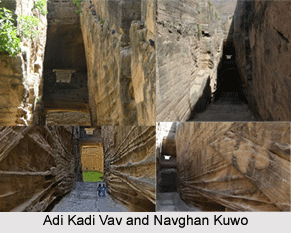 Adi-Kadi Vav and Navghan Kuwo are the famous stepwells, located in the region of Uparkot in the western Indian state of Gujarat. It is said that these historical stepwells are unique as they are built in strikingly different styles, as compared to their counterparts on the other portions of the country. The spaces in between the steps of the stepwells Navghan Kuwo and Adi-Kadi Vav have been constructed with the help of stone, wherein the main structure of the well including the walls and the columns have been erected from rock. Generally, other stepwells are dug out through different layers of rocks and subsoil, unlike these two stepwells which have been carved out naturally, out of a single stone.
Adi-Kadi Vav and Navghan Kuwo are the famous stepwells, located in the region of Uparkot in the western Indian state of Gujarat. It is said that these historical stepwells are unique as they are built in strikingly different styles, as compared to their counterparts on the other portions of the country. The spaces in between the steps of the stepwells Navghan Kuwo and Adi-Kadi Vav have been constructed with the help of stone, wherein the main structure of the well including the walls and the columns have been erected from rock. Generally, other stepwells are dug out through different layers of rocks and subsoil, unlike these two stepwells which have been carved out naturally, out of a single stone.
Navghan Kuwo Stepwell
Navghan Kuwo is an ancient stepwell which was erected around 1026 AD, though certain historical accounts assert that it was created many more years ago. Part of this stepwell has been constructed from soft rock and the other half has been erected just like any other ordinary stepwell. The water existent inside this stepwell had once been a great boon for the inhabitants of Uparkot, especially during long sieges. Stairs of Navghan Kuwo stepwell lead down to a length of nearly 52 metres.
Adi-Kadi Vav Stepwell
Constructed during the 15th century, Adi-Kadi Vav stepwell is made out of a single piece of hard rock and consists of a series of 120 stairs which are connected to a well shaft at the bottom of the stepwell. Two different legendary tales are associated to this ancient stepwell. As per one of these legends, there existed a king who had ordered workers to create this stepwell. However, once the stepwell was constructed, it was soon discovered that no water was to be found here. The royal priest had foretold that unless two unmarried girls would be sacrificed, no water would be found. Accordingly, two girls named Adi and Kadi were sacrificed and finally, water was found in this stepwell. There is yet another legend which states that there were two servant girls by the names of Adi and Kadi who used to fetch water from this step well regularly. The actual story of the origin of the name of Adi-Kadi Vav remains shrouded in mystery. Even today, people hang bangles and clothes on a tree located close to Adi-Kadi Vav to honour the memory of the two girls.



















